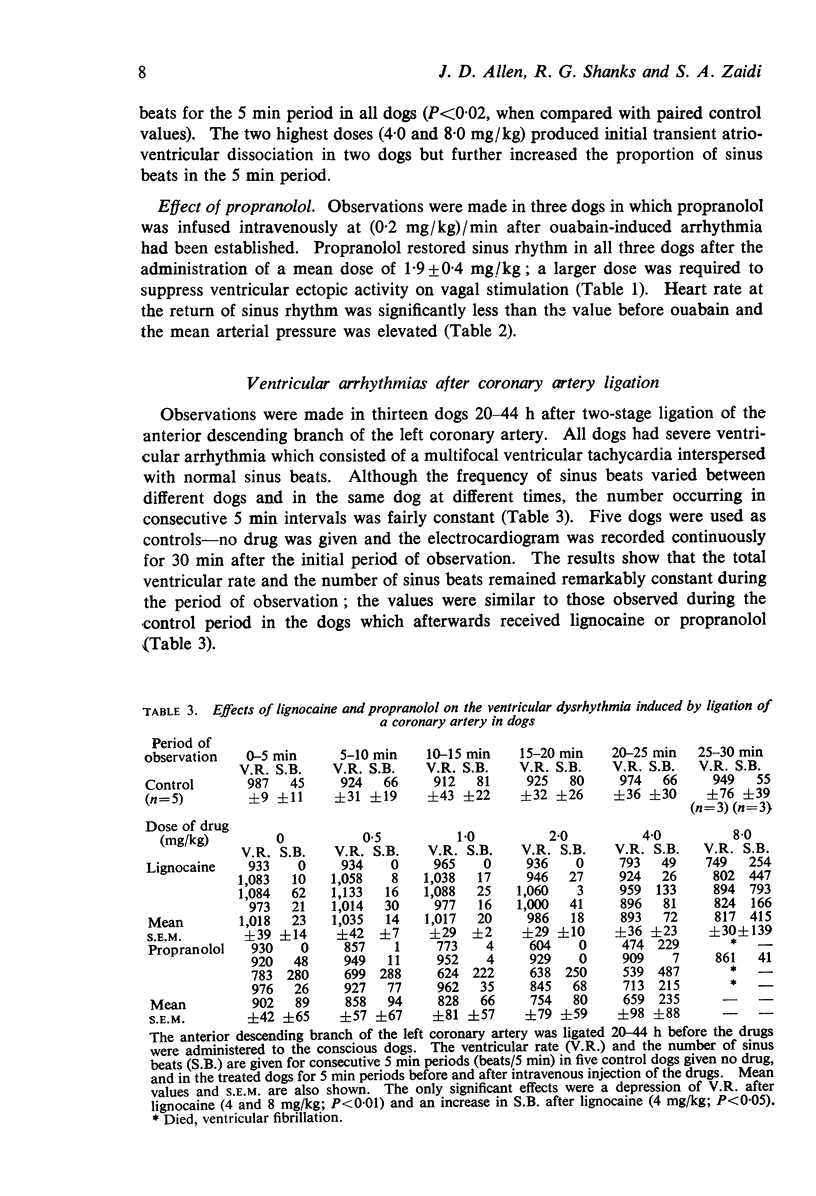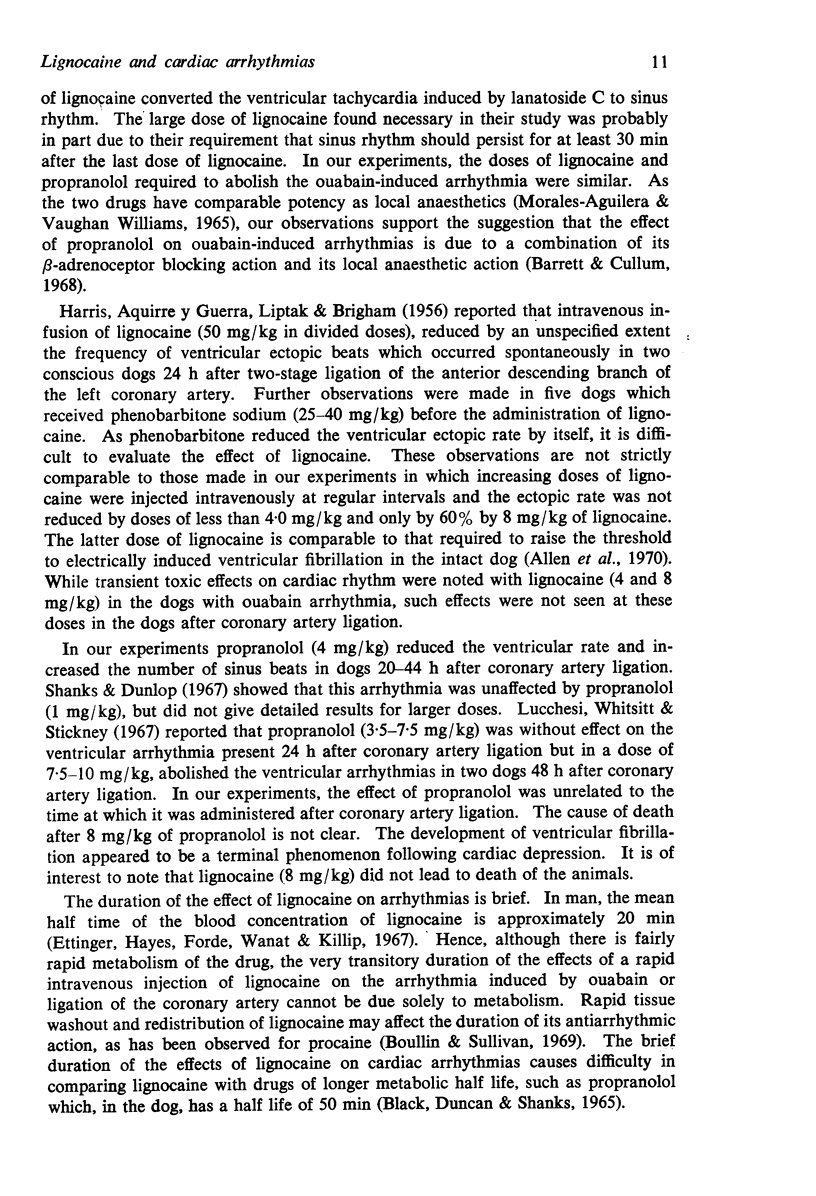Abstract
1. The effects of intravenous injection of lignocaine and propranolol were studied in dogs.
2. Ventricular ectopic beats produced by intravenous injection of adrenaline in anaesthetized dogs respired with halothane were abolished in four out of six dogs by lignocaine. Propranolol was effective in all three dogs tested.
3. Intravenous infusion of lignocaine at (0·2 and 1·0 mg/kg)/min to total doses of 3·0 ± 1·0 and 2·2 ± 0·5 mg/kg, respectively, abolished the ventricular tachycardia produced in anaesthetized dogs by ouabain. A similar effect was produced by infusion of propranolol at (0·2 mg/kg)/min to a total dose of 1·9 ± 0·4 mg/kg. Intravenous injection of single doses of lignocaine (4·0-8·0 mg/kg) also abolished the arrhythmia.
4. The frequency of the ventricular ectopic beats occurring in conscious dogs 20-44 h after ligation of the anterior descending branch of the left coronary artery was reduced, with an increase in the number of sinus beats, after intravenous injection of lignocaine (8·0 mg/kg). Larger doses produced excitement. Propranolol (4·0 mg/kg) had a greater effect than the same dose of lignocaine but after 8·0 mg/kg, three of the four dogs died.
5. Propranolol was more effective than lignocaine in abolishing the three different types of arrhythmia.
6. Dose-response curves showed that lignocaine was more active in abolishing the ouabain induced arrhythmia than the halothane-adrenaline arrhythmia and was least active on the arrhythmia caused by ligation of the coronary artery.
Full text
PDF











Selected References
These references are in PubMed. This may not be the complete list of references from this article.
- Bigger J. T., Jr, Mandel W. J. Effect of lidocaine on conduction in canine Purkinje fibers and at the ventricular muscle-Purkinje fiber junction. J Pharmacol Exp Ther. 1970 Apr;172(2):239–254. [PubMed] [Google Scholar]
- Bigger J. T., Jr, Mandel W. J. Effect of lidocaine on the electrophysiological properties of ventricular muscle and purkinje fibers. J Clin Invest. 1970 Jan;49(1):63–77. doi: 10.1172/JCI106224. [DOI] [PMC free article] [PubMed] [Google Scholar]
- Black J. W., Duncan W. A., Shanks R. G. Comparison of some properties of pronethalol and propranolol. Br J Pharmacol Chemother. 1965 Dec;25(3):577–591. doi: 10.1111/j.1476-5381.1965.tb01782.x. [DOI] [PMC free article] [PubMed] [Google Scholar]
- Boullin D. J., Sullivan T. J. Relationship between the uptake, binding and pharmacological action of procaine in the isolated heart. Br J Pharmacol. 1969 Feb;35(2):322–331. doi: 10.1111/j.1476-5381.1969.tb07991.x. [DOI] [PMC free article] [PubMed] [Google Scholar]
- Davis L. D., Temte J. V. Effects of propranolol on the transmembrane potentials of ventricular muscle and Purkinje fibers of the dog. Circ Res. 1968 May;22(5):661–677. doi: 10.1161/01.res.22.5.661. [DOI] [PubMed] [Google Scholar]
- Davis L. D., Temte J. V. Electrophysiological actions of lidocaine on canine ventricular muscle and Purkinje fibers. Circ Res. 1969 May;24(5):639–655. doi: 10.1161/01.res.24.5.639. [DOI] [PubMed] [Google Scholar]
- Dunlop D., Shanks R. G. Selective blockade of adrenoceptive beta receptors in the heart. Br J Pharmacol Chemother. 1968 Jan;32(1):201–218. doi: 10.1111/j.1476-5381.1968.tb00444.x. [DOI] [PMC free article] [PubMed] [Google Scholar]
- HARRIS A. S., AGUIRRE Y GUERRA C., LIPTAK R. A., BRIGHAM J. C. Effects of certain local anesthetic drugs upon ventricular tachycardia resulting from myocardial infarction. J Appl Physiol. 1956 Mar;8(5):499–503. doi: 10.1152/jappl.1956.8.5.499. [DOI] [PubMed] [Google Scholar]
- Hilmi K. I., Regan T. J. Relative effectiveness of antiarrhythmic drugs in treatment of digitalis-induced ventricular tachycardia. Am Heart J. 1968 Sep;76(3):365–369. doi: 10.1016/0002-8703(68)90232-9. [DOI] [PubMed] [Google Scholar]
- Katz M. J., Zitnik R. S. Direct current shock and lidocaine in the treatment of digitalis-induced ventricular tachycardia. Am J Cardiol. 1966 Oct;18(4):552–556. doi: 10.1016/0002-9149(66)90010-5. [DOI] [PubMed] [Google Scholar]
- Lucchesi B. R., Iwami T. The antiarrhythmic properties of ICI 46037, a quaternary analog of propranolol. J Pharmacol Exp Ther. 1968 Jul;162(1):49–59. [PubMed] [Google Scholar]
- Lucchesi B. R., Whitsitt L. S., Stickney J. L. Antiarrhythmic effects of beta adrenergic blocking agents. Ann N Y Acad Sci. 1967 Feb 10;139(3):940–951. doi: 10.1111/j.1749-6632.1967.tb41262.x. [DOI] [PubMed] [Google Scholar]
- MORALES AGUILERA A., VAUGHANWILLIAMS E. M. THE EFFECTS ON CARDIAC MUSCLE OF BETA-RECEPTOR ANTAGONISTS IN RELATION TO THEIR ACTIVITY AS LOCAL ANAESTHETICS. Br J Pharmacol Chemother. 1965 Apr;24:332–338. doi: 10.1111/j.1476-5381.1965.tb01719.x. [DOI] [PMC free article] [PubMed] [Google Scholar]
- Mendez R., Kabela E. Cardiac pharmacology. Annu Rev Pharmacol. 1970;10:291–312. doi: 10.1146/annurev.pa.10.040170.001451. [DOI] [PubMed] [Google Scholar]
- SCHLESINGER M. J. New radiopaque mass for vascular injection. Lab Invest. 1957 Jan-Feb;6(1):1–11. [PubMed] [Google Scholar]
- Shanks R. G., Dunlop D. Effect of propranolol on arrhythmias following coronary artery occlusion in dogs. Cardiovasc Res. 1967 Jan;1(1):34–41. doi: 10.1093/cvr/1.1.34. [DOI] [PubMed] [Google Scholar]


